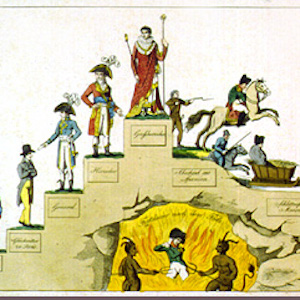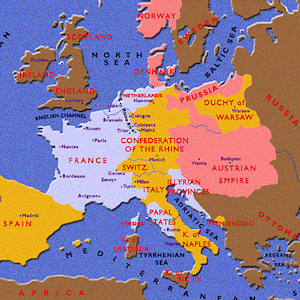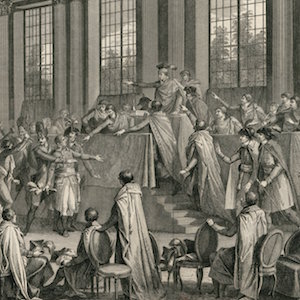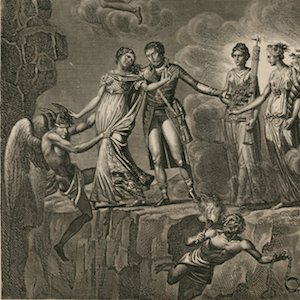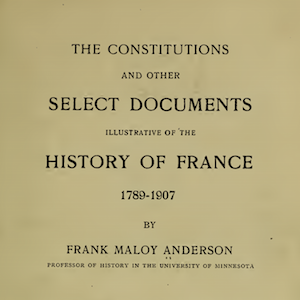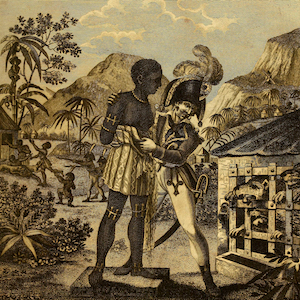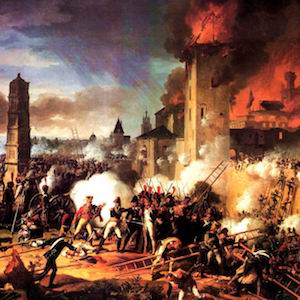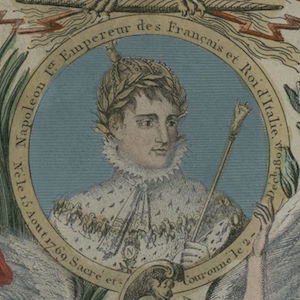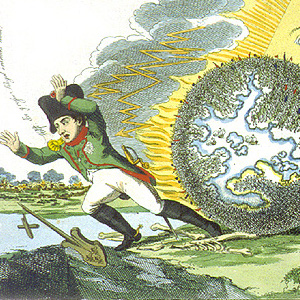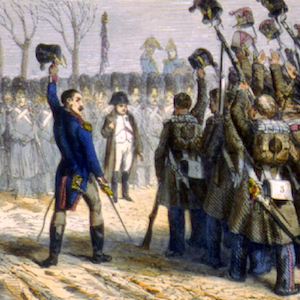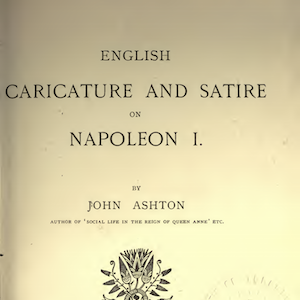Source Collection: The Napoleonic Experience
Overview
The bare facts of the life of Napoleon Bonaparte stagger the imagination and rival the plots of the most fantastic novels. Born in 1769 in Ajaccio, Corsica, just as that island was passing from the hands of the Republic of Genoa to those of France, Bonaparte attended a French military school for impoverished sons of the nobility. Unlike many French nobles, he supported the Revolution, and thanks to a combination of skill, luck, and patronage, he was given command of the Italian campaign in 1796 (at the ripe old age of 27!). He invaded Egypt in 1798, took charge of a new government in 1799, had himself named First Consul for Life in 1802, and crowned himself Emperor in 1804.
This source collection consists of 70 primary sources, including maps, written correspondence, and songs.
Essay
His fall from the pinnacle of power was almost as startling as his rise. In 1812 he invaded Russia, where he won most of the battles but lost an army in the process. Within two years the powers allied against him had captured Paris. Forced into exile on the island of Elba, Napoleon escaped to fight one last time. When he lost his final battle at Waterloo in Belgium in 1815, the victors sent him to the faraway island of Saint Helena, where he died in 1821. The eagle (his preferred symbol) had taken its last flight.
Napoleon created a new form of government in France, reshaped the boundaries of Europe, and influenced revolutionaries and nationalists the world over. Since his first days in power he aroused controversies that continue today. Was he a true son of the Enlightenment who modernized French government and brought the message of equality under the law wherever he went? Or was he an authoritarian military dictator who fought incessant wars and conquered territory in order to maintain his egomaniacal grip on power? There is abundant evidence for both views. The evidence is presented here under three main headings: Domestic Policies; Foreign Policies and Wars; and His Legacy.
Domestic Policies
How did a young Corsican from a minor noble family, whose native language was not even French, become supreme ruler of one of the most important powers in Europe? The answer has to be sought in the impact of an expanding war on revolutionary politics. From 1792 to 1794, the French armies struggled to save the Republic from its foreign and internal enemies. In 1794 the tide turned, enabling France to go on the offensive and to carry the war to its neighbors rather than desperately fight to save itself. But war was expensive, and the Directory government (1795–99) encouraged its generals to exact tribute from the local populations they "liberated" in order to pay for the maintenance of the armies. While fighting far from France, the generals acted more and more on their own, paying their armies out of local treasure and overseeing the administration of conquered territories.
Like the other generals, Napoleon Bonaparte benefited from this system, but he stood out from them because of his remarkable talent for seizing every military opportunity. In 1796 he took a ragtag army of 40,000 soldiers and swept the Austrian armies out of their possessions in Italy. When he returned to Paris in November 1797 bearing the treaty that he himself had negotiated with the Austrians, giving France control over much of Italy, Belgium, and the Rhineland, the French welcomed him as a hero. His taste of power and glory in Italy inspired him with great ambitions for the future. "I saw the world spin beneath me," he exulted, "as if I were flying through the air."
He invaded Egypt next and though trapped when the English destroyed his fleet, he escaped to France in October 1799 at a critical moment in the political affairs of the Republic. Leading members of the government secretly sought a constitutional overhaul and they needed a general to make their plot work. Napoleon appeared at just the right moment, but his arrogance and bluster nearly lost the day. He forced his way into a meeting of the deputies, who threatened to outlaw him as a would-be dictator. He and his brother Lucien, rallying some troops waiting outside, broke up the session by armed force. Napoleon was then named First Consul. The plotters in the legislature expected to control the young general (he was not old enough to hold office under the Constitution of 1795), but they soon found themselves outmaneuvered.
Napoleon steadily gained support for the new regime by promising a regime of law and order and by making peace with the Catholic Church and its head, the pope.
Although probably not motivated by personal religious conviction, he did believe that good relations with the Catholic Church were essential to maintaining order and guaranteeing his own legitimacy. Some conflicts over religion continued, but the pope had granted Napoleon more or less everything he wanted in exchange for bringing France back into the Catholic fold. Napoleon reaffirmed the principle of religious toleration for Protestants, who were organized in a number of consistories under state control. After 1804 the state paid the salaries of Protestant pastors, just as it paid those of Catholic priests. In 1806 Napoleon organized French Jews into a system of government-supervised consistories like those that regulated Protestant worship. He did everything possible to encourage Jewish assimilation to French ways. As was typical of Napoleon, he hoped to guarantee law and order by organizing all the groups in society under state control.
At the same time that these important restructurings of the state and its relations with France's main religions were taking place, Napoleon won great prestige by coming to terms first with Austria in 1801, which had resumed the struggle in 1799, and then making peace with Britain, Spain, and the Dutch Republic in 1802, ending a decade of nearly nonstop war. Peace gave him the breathing room to send an army to Saint Domingue to reestablish slavery in the colonies and capture Toussaint L'Ouverture; even though the army captured Toussaint and sent him to die in a French prison, Napoleon's army succumbed to yellow fever and to the tenacity of the former slaves, who established the Republic of Haiti and severed all connections with France. Although the peace in Europe proved short-lived too, it gave Napoleon time to have himself declared Consul for Life in a referendum in 1802.
By the end of 1802, the Republic had essentially ceased to exist and a new authoritarian state was taking shape. Elections no longer had much meaning. Napoleon set up a Legion of Honor to reward military and bureaucratic service to his state. It was the embryo of a new nobility. Newspapers were suppressed, unruly theaters closed, and critical authors sent into exile. Finally, the new direction became clear: on 2 December 1804, Napoleon crowned himself Emperor with the pope watching. A new civil code consolidated revolutionary legislation by confirming all the sales of property undertaken since 1789 and guaranteeing equality under the law. But the Napoleonic Code also installed a more paternalistic legal system than that envisioned by the revolutionaries: husbands and fathers gained nearly complete control over their wives and children, and employers wielded great authority over their workers. Even while confirming some of the legal gains of the revolutionary decade, Napoleon labored assiduously to cultivate the loyalties of those who had suffered during the Revolution such as the old regime nobility. In some large measure, he succeeded.
Emperor Napoleon I had created a new kind of hybrid state in which certain revolutionary ideas (equality under the law, careers open to merit rather than birth, the abolition of the remains of feudalism) were combined with an authoritarian state structure and a new nobility open to those who served the state well. As time passed, Napoleon increasingly emulated the court of the old regime monarchy. He hoped to take his place among the legitimate monarchs of Europe and even married a Habsburg to establish his credentials. Although this hybrid state enjoyed broad support among the French people, neither the state nor the popular support survived defeat in war.
Foreign Policies and War
Napoleon's dramatic rise and fall depended from beginning to end on his fortunes at war. His unexpected successes in Italy in 1796–97 made him an instant legend, both among the French people at home and among his soldiers in the Army of Italy. Yet from the very start of his ascent, overreaching ambition proved to be a potentially fatal flaw. When Napoleon returned from Italy in 1797, the Directory government wanted to send him off to invade England, mainly to get him out of town. Napoleon convinced them that an invasion of Egypt would suit their purposes better, for it would open the route to India where Great Britain had earlier expelled the French and established an important empire. Napoleon focused his ambition on Egypt because of its historical importance, not because it was a viable strategic objective: "We must go to the Orient," he insisted. "It is there that great glory has always been gained." His search for glory nearly ended his career.
Napoleon invaded Egypt in early July 1798 on the pretense that he was reasserting the Ottoman sultan's authority there against the local Mameluke rulers. In the Battle of the Pyramids outside Cairo, Napoleon's soldiers smashed the Mameluke cavalry. It was one of the few glorious moments of the Egyptian campaign. He was so confident of his ultimate success that he brought with him scores of scientists, engineers, and archaeologists to study the treasures and riches of the Orient.
But on 1 August 1798, British Admiral Horatio Nelson trapped the French fleet in Aboukir Bay off the Egyptian coast and captured or destroyed all but four of the French ships. The destruction of the French fleet left the army in Egypt cut off from France and ensured the dominance of the British in the Mediterranean. From there the situation deteriorated. Despite Napoleon's attempts to respect the Islamic religion, his occupation aroused resentment and revolt. Napoleon marched his troops into the province of Syria in early 1799 but was forced to retreat to Egypt by an outbreak of the plague and the difficulty of supplying his army. A clever stream of propaganda kept the French at home ignorant of his troubles.
Napoleon's elevation to the successive positions of First Consul, First Consul for Life, and then Emperor only enhanced his interest in the pursuit of glory through military means. Indeed, from 1800 to 1812 it seemed as if nothing could prevent him from attaining dominion over all of Europe. In seeking this goal, he received vital assistance from the divisions among his enemies, who frequently made a separate peace with Napoleon either to cut their losses or to pursue their own advantage in alliance with him. Yet Napoleon was not content with a merely European theater in his quest of greatness; he hoped to establish some kind of worldwide empire. To this end he tried to extend France's colonies in the New World by retrieving Louisiana from the Spanish and by invading Saint Domingue; eventually, he sold the one and gave up on the other. He also sent agents to Persia and India, tried to claim a part of the coast of Australia, and dispatched army officers to investigate defenses in North Africa. Most of these plans for world empire were frustrated by his inability to defeat the British at sea. In October 1805 Nelson again decimated the French fleet, this time in the Battle of Trafalgar near the Straits of Gibraltar. Nelson died but lost no ships; the French saw two-thirds of theirs sunk or destroyed.
On the continent, Napoleon's well-trained armies ensured an altogether different outcome. In 1805 a new coalition to oppose Napoleon took shape uniting Great Britain, Russia, and Austria, with Prussia threatening to join at any moment. On 2 December 1805, Napoleon routed the Austrians and Russians at the Battle of Austerlitz. The Prussians then foolishly tried to take him on by themselves and suffered a disastrous string of defeats. Napoleon seized the occasion to remake the map of the German states, joining all of them except Austria and Prussia in a Confederation of the Rhine. With this new confederation under his influence, Napoleon declared himself the true successor to Charlemagne. Seeing which way the wind was blowing, Francis II had abdicated his title as Emperor of the Holy Roman Empire a few years before, becoming merely the Emperor of Austria. Napoleon then turned his ire on the Russians. After a series of hard-fought contests, Alexander I made peace. By the terms of the Tilsit Treaty, Prussia gave up one-third of its territory, and France and Russia secretly agreed to ally together against England, a promise that neither intended to keep.
Between 1806 and 1810, Napoleon reached the height of his power in Europe. He made himself king of a newly amalgamated Italy in 1805, which brought together extensive territories in northern and central Italy. He installed his brother Joseph as King of Naples in 1806 before moving him to the kingdom of Spain in 1808. He made his brother Louis King of the Netherlands in 1806. In 1807 he named his brother Jerome King of Westphalia. He could put his relatives on the thrones of Europe because he could defeat all his rivals via a straightforward land invasion except one, Great Britain. Recognizing that he could not invade the island nation, he tried to isolate Great Britain commercially through an embargo of goods called the "continental system" of 1806. The system failed because the French could not provide the same manufactured goods as Great Britain for even somewhat similar prices. Thus, despite official prohibitions, massive state intervention, and the expansion of the country to include prosperous areas in Belgium, Germany, and Italy, France could not compete with the rapidly industrializing British.
In the long run, the failure of this continental blockade spelled the beginning of the end. To make the embargo on trade more encompassing, Napoleon invaded Portugal and then occupied Spain in 1808. The Spanish rebelled and with financial and military support from Britain, they tied Napoleon's armies down in a long guerrilla war. Even Napoleon's personal intervention with 150,000 additional troops could not stabilize the French takeover. The French continued to win many battles but were gradually losing the war in Spain and Portugal. By 1813 British, Portuguese, and Spanish troops had driven out the French. In Latin America, local patriots seized the moment of turmoil in Spain to press their own demands for independence, marking an important turning point in the region's political development. Events in Latin America did nothing to help Napoleon in Europe.
Napoleon fell from power because he could not dispose of either Great Britain or Russia. While the British stubbornly resisted the French in the Iberian peninsula, Tsar Alexander I abandoned his alliance with France and began to prepare for war once again. The British promised subsidies, and the Russians carried on a secret trade in British goods. In June 1812, Napoleon entered Russian territory with 500,000 troops. As he advanced, the Russians retreated, destroying food and fodder in a calculated "scorched-earth" policy. After a hard-won victory at Borodino outside Moscow, his now much-diminished army entered Moscow on 14 September, only to have the Russians torch the city. After five weeks of futilely waiting for Alexander to come to terms, Napoleon ordered a general withdrawal. Before long, winter set in, dashing French hopes for an orderly retreat. Tens of thousands of soldiers froze to death; thousands of others lost their lives to marauding Russian soldiers or enraged peasants. The Russians had not exactly won the campaign, but the French had lost and even admitted tactical defeat. Napoleon returned with approximately 40,000 men.
The end was now approaching fast. Emboldened by the French army's unexpected losses and the success of their own internal reforms, all the great powers had by September 1813 joined again in a coalition designed to bring down the French Emperor. After the two sides fought a generally inconclusive battle at Leipzig in October (called the Battle of the Nations) that resulted in the defection of a large part of his forces, Napoleon now had only 100,000 soldiers left to defend France. The allied victories were fueled by a wave of patriotic enthusiasm that swept the German states, as young men joined up to liberate Germany from French control. By March 1814, the allied armies had captured Paris. In April his own officials pressured Napoleon to abdicate in favor of the brother of Louis XVI, known as Louis XVIII because Louis XVI's son, who would have been Louis XVII, had died in captivity. Napoleon tried to kill himself with poison but failed and went into exile on the island of Elba.
While the European powers were meeting to decide the terms of peace, Napoleon learned that many in France resented the changes introduced by the new Bourbon King, Louis XVIII. On 26 February 1815, he escaped with 1,100 men and returned to France to begin what became known as "the Hundred Days." Louis fled when unit after unit went over to Napoleon. The allies gathered their armies for another showdown; they outnumbered Napoleon two to one. On 18 June 1815, the final battle was engaged at Waterloo in Belgium. The Prussians joined up with the army under the command of the Duke of Wellington, victor over the French in Spain and Portugal, and together they defeated Napoleon, who abdicated again. This time he was sent off to distant Saint Helena in the South Atlantic, far from Europe. He died there six years later.
Contemporary Views of Napoleon
Napoleon Bonaparte was a legend even before he died, and his death did nothing to diminish his stature in history. Those around him in his final days almost immediately published their version of his story, including his British physician Edward O'Meara, who complained of the petty persecutions directed by his own government against his patient. Although Napoleon did not himself write memoirs, he provided ample material for those close to him to do so.
In part, the memory of Napoleon was also shaped by his adoption of many liberal principles during the brief Hundred Days interlude. The prime example was the Constitution of 1815, written by Benjamin Constant. Although most doubt the sincerity of Napoleon's commitment to liberalism, his ideas did inspire some to take the gamble of giving him their support, and it left the image of a "Napoleon of the people" in some minds. The peasantry of northern France, in particular, who liked the pageantry of the regime and the high wages for rural labor caused by the wars, would remember the Napoleonic epoch fondly as a time of glory and prosperity.
Among the most perceptive commentators on Napoleon were those in the liberal opposition. Germaine de Staël and Benjamin Constant both sought to understand Napoleon's appeal and his effects on revolutionary and republican France. They disliked many aspects of his personality and rule but also recognized that his charismatic style of government had fundamentally changed the rules of politics. Even his most determined enemies, such as the English, could not suppress a sneaking admiration for his accomplishments. And for some in the lower classes, he seemed a welcome change from boring run-of-the-mill monarchs.
Although many, both within and outside France, opposed Napoleon's repressive government and imperialist ambitions, they would nonetheless find it difficult to deny that he cut an extraordinary figure. Anyone born before 1830 or even 1840, especially in France, would have grown up with the legend of Napoleon all about them, in stories, in songs, and in widely reprinted popular engravings. Leading politicians and artists of the nineteenth century worked in his shadow. Even the most convinced republicans could not help feeling nostalgic about some aspect of the Napoleonic experience.
Primary Sources
Credits
From LIBERTY, EQUALITY, FRATERNITY: EXPLORING THE FRENCH REVOLUTION, https://revolution.chnm.org/exhibits/show/liberty--equality--fraternity/napoleonic-experience
